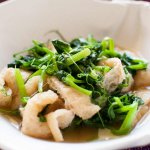
Snow pea leaves and aburaage (fried thin tofu) are simmered in a lightly flavoured dashi stock. This salad can be served warm, cold or at room temperature. This is a great make-ahead dish.
Use konbu dashi and make it 100% vegetarian.
- 100g/3.5oz snowpea leaves/snowpea shoots (note 1)
- 1 sheet aburaage (note 2)
- 2 cups boiling water
- 150ml/5.1oz dashi stock (note 3)
- 1 tbsp light soy auce (note 4)
- ½ tbsp mirin
- ¼ tsp salt
-
Cut the bunch of snow pea shoots into 5cm/2” long pieces so that they are easier to pick up when eating.
-
Pour 2 cups of boiling water over aburaage to remove excess oil, then squeeze water out. Cut the aburaage in half lengthwise, then cut into 5mm/3/16" wide strips crosswise.
-
Add the Sauce ingredients to a saucepan and heat over high heat.
-
When the sauce starts boiling, add aburaage and then snow pea leaves. Push the snow pea leaves down with chopsticks or a fork so that they are submerged in the sauce.
-
After it starts boiling and snow pea leaves are all wilted, turn the heat off and leave it for minimum 15 minutes (note 5).
-
Transfer the snow pea leaves and aburaage to serving bowls and pour all the broth over the top.
1. Snow pea leaves (also called snow pea shoots/tips) are snow pea stalks with broad leaves intact (see the photo in post). They are not the same as snow pea sprouts. You can buy a pack of snow pea leaves at vegetable shops where other salad leaves are sold.
2. You can buy aburaage from Japanese/Asian grocery stores, it is usually sold frozen. More details about aburaage can be found in my post, Shimeji Gohan.
3. I would encourage you to make dashi stock from scratch using konbu (kelp) and bonito flakes (Awase Dashi). But if you are using a dashi pack, try to find a pack with no additives.
If you need to use other kind of dashi pack, reduce the amount of salt in the Ingredients as the dashi pack already contains salt.
Use konbu dashi to make the dish 100% vegetarian.
4. You can substitute it with normal Japanese soy sauce. Dark soy sauce is not suitable for this dish.
5. Some recipes serve immediately after turning off the heat but I find that letting it cool for 15 minutes or more allows the flavour of the broth penetrate the vegetables.
But if you are in a hurry, you can serve it immediately. It's still delicious.
You can make ahead up to 2-3 days and leave it in the fridge. If you prefer it to be served hot/warm, re-heat before serving.
6. Nutrition information per serving:
serving: 430g calories: 91kcal fat: 3.9g (6%) saturated fat: 0.7g (27%) polyunsaturated fat: 1.8g monounsaturated fat: 0.9g cholesterol: 1.2mg (0%) sodium: 1031mg (43%) potassium: 324mg (9%) carbohydrates: 7.1g (2%) dietary fibre: 1.9g (8%) sugar: 4g protein: 7.4g vitamin a: 11% vitamin c: 50% calcium: 6.8% iron: 10%